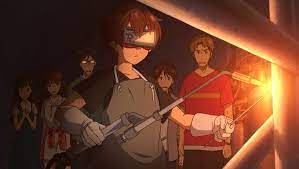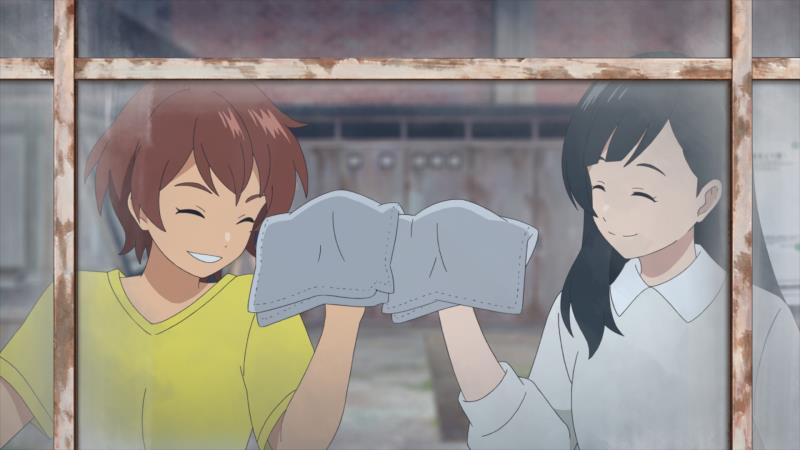Seven Days War
September 24, 2022 · 0 comments
By Shelley Pallis.

Mamoru and Aya have known each other since they were six years old, but now they are awkward teens… well, he is an awkward teen, unable to express his true feelings for his childhood friend, and panicking now that she is about to move away. In a moment of weakness, he proposes that they run away to “celebrate her birthday”, leading to a tense and comical journey in which it is never quite sure Aya shares his feelings or not. For starters, she has told the rest of their classmates, leading to an unexpected confrontation at their abandoned coal refinery hideaway, when Mamoru discovers that there are a bunch of gate-crashers at his would-be romantic tryst.
Half a dozen teenagers in an abandoned coal plant sounds like a recipe for a B-movie horror plot, but instead screenwriter Ichiro Okouchi turns it into a week’s vacation from the norm – with a gentle concentration on cooking, cleaning and logistics that recalls the recent House of the Lost on the Cape as well as some soul searching in the style of this year’s fellow festival title Goodbye, Don Glees. Before long, the teenagers are thrown into a wider conspiracy, as heavies arrive to both retrieve the arrant Aya before her anxious father’s “shame” becomes public, and to round up Malet, a Thai immigrant in hiding whose parents are attempt to arrange visas to stay in Japan. In other words, as the days tick by, this is a film that charmingly pitches a new format: Big Brother, if the house were constantly under attack from hapless henchmen, and the inmates obliged to fight back with improvised weapons like some sort of A-Team.

Seven Days War is a franchise that began in 1985 with the original, Our Seven Days War by Osamu Soda. Soda’s book featured Eiji Kikuchi, an idealistic teen who persuades half a dozen of his fellow students to barricade themselves in a deserted factory on the edge of town, in protest at various school injustices and corporal punishments. This, in turn, was inspired by Japan’s very own 1968 protests, the riots and demonstrations orchestrated by the “Zenkyoto” federation of student unions, regarded as a high-point of grass-roots protests in Japan.
In multiple accounts of Japanese history, including those relating specifically to anime, the 1968 protests are seen as some sort of last hurrah, an anti-establishment wave that was crushed by right-wing retaliations and the imposition of decades of conservativism. In a polemic included as the introduction to the collection Debating Otaku, the critic Eiji Otsuka regards 1968 as a flashpoint in boomer disenchantment, refugees from which piled into a limited number of hiding places in the media, including anime. Imagine a world, he suggests, only partly in jest, where the likes of Yoshiyuki Tomino could have made real films or become public servants, instead of slumming it making kids’ cartoons. The riots’ most obvious manifestation in anime is as the inspiration for the civil unrest glimpsed 20 years later in Katsuhiro Otomo’s Akira, but the same general tone of protest informed everything from labour disputes at Japanese animation studios to Ryu Murakami’s satire 69, to the plotline of Soda’s original novel Our Seven Days War a generation later.

Soda’s characters were performatively idealistic, disaffected youths determined to protest about something, but also touchingly sure that they could get results. A 1988 live-action movie adaptation by Hiroshi Sugawara, kept the same plot and largely played it for laughs, as if Lindsay Anderson’s student-rebellion classic If were remade by the people who produced Home Alone. A climactic sequence, in which the students commandeered a conveniently available tank, was pointedly made without support of the Japanese military, who refused to get involved in such japes.
Yuta Murano’s anime feature, with a 2019 release date that suggests it was originally intended for the fiftieth anniversary of the 1968 protests and sit-ins, takes the message of protest and idealism to a new 21st century level. As with the live-action film, it both honours and lampoons the passions of idealistic youth – our new hero, Mamoru, is introduced as a history nerd with an interest in siege warfare and the Paris Commune, but also as a lovestruck teenager whose real interest may very well be nothing more than hanging onto his classroom love-interest for another week before she moves away. Politics, in that interpretation, is less of a true motivation than a stick with which to beat Aya’s father, who is moving to run for office in That Fancy Tokyo, and desperate to cover up the fact that his daughter has “run away” before it affects his media profile.

Murano’s feature film is notable for slick editing, with repeated cuts that masterfully move foreground animation into situations with new backgrounds. It also plays up a contemporary issue of far greater weight today than it was fifty years ago – Japan’s attitude towards immigrant labour. With Japan facing a population crisis (as well it might, considering how hapless Aya and Mamoru are at flirting), an increasing reliance on overseas workers is causing all sorts of friction in a supposedly homogenous society. Malet serves as a winning mouthpiece for the other side – a despondent migrant whose parents were lured to Japan under false pretences.
A recurring gag in the film has Mamoru attempting to explain some important historical point or icon, only to have everybody else distracted by mundane concerns like what someone else is wearing, or someone’s new hairstyle. “The only place where people pay attention” to him is a chatroom populated by fellow war nerds in their sixties, suggesting that kids today are largely apathetic and apolitical. If so, that seems like an oddly blinkered view of today’s teens, who are growing up and reacting to a veritable jackpot of transformations – climate change, global recession and wild fluctuations in identity politics and their consequences. As Makoto Shinkai observed in the sleeve notes to his Weathering with You, the standard formulas of action films, in which our stalwart heroes are sure to save the world in 90 minutes, can seem trite and deluded in the 2020s.
But Seven Days War also seems targeted not merely at teens, but at the adult audience who can enjoy the nostalgia of the teens that they used to be. “We were once the revolutionaries”, as one reviewer of the live-action film pointedly noted. Or to put it in the words of a character from the film, “youth is our liberated area.”
Seven Days War is screening as part of this year’s Scotland Loves Anime.
Leave a Reply